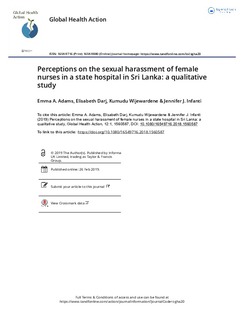| dc.contributor.author | Adams, Emma A. | |
| dc.contributor.author | Darj, Elisabeth | |
| dc.contributor.author | Wijewardene, Kumudu | |
| dc.contributor.author | Infanti, Jennifer | |
| dc.date.accessioned | 2019-04-01T07:39:17Z | |
| dc.date.available | 2019-04-01T07:39:17Z | |
| dc.date.created | 2019-02-26T14:06:53Z | |
| dc.date.issued | 2019 | |
| dc.identifier.issn | 1654-9880 | |
| dc.identifier.uri | http://hdl.handle.net/11250/2592598 | |
| dc.description.abstract | Background: Sexual harassment occurs within the nursing profession globally, challenging the health and safety of nurses and the quality and efficiency of health systems. In Sri Lanka, no studies have explored this issue in the health sector; however, female employees face sexual harassment in other workplace settings. Objective: To explore female nurses’ perceptions of workplace sexual harassment in a large state hospital in Sri Lanka. Methods: This is a qualitative study conducted in an urban, mainly Buddhist and Singhalese context. We invited all female senior and ward nurses working in the hospital to participate in the study. We conducted individual in-depth interviews with four senior nurses and focus group discussions with 29 nurses in three groups. Results: The nurses described a variety of perceived forms of sexual harassment in the hospital. They discussed patient-perpetrated incidents as the most threatening and the clearest to identify compared with incidents involving doctors and other co-workers. There was significant ambiguity regarding sexual consent and coercion in relationships between female nurses and male doctors, which were described as holding potential for exploitation or harassment. The nurses reported that typical reactions to sexual harassment were passive. Alternatively, they described encountering inaction or victim blaming when they attempted to formally report incidents. They perceived that workplace sexual harassment has contributed to negative societal attitudes about the nursing profession and discussed various informal strategies, such as working in teams, to protect themselves from sexual harassment in the hospital. Conclusions: Sexual harassment was a perceived workplace concern for nurses in this hospital. To develop effective local prevention and intervention responses, further research is required to determine the magnitude of the problem and explore differences in responses to and consequences of sexual harassment based on perpetrator type and intent, and personal vulnerabilities of the victims, among other factors. | nb_NO |
| dc.language.iso | eng | nb_NO |
| dc.publisher | Taylor & Francis Open | nb_NO |
| dc.relation.uri | https://www.tandfonline.com/doi/full/10.1080/16549716.2018.1560587 | |
| dc.rights | Navngivelse 4.0 Internasjonal | * |
| dc.rights.uri | http://creativecommons.org/licenses/by/4.0/deed.no | * |
| dc.title | Perceptions on the sexual harassment of female nurses in a state hospital in Sri Lanka: a qualitative study | nb_NO |
| dc.type | Journal article | nb_NO |
| dc.type | Peer reviewed | nb_NO |
| dc.description.version | publishedVersion | nb_NO |
| dc.source.volume | 12 | nb_NO |
| dc.source.journal | Global health action | nb_NO |
| dc.source.issue | 1 | nb_NO |
| dc.identifier.doi | 10.1080/16549716.2018.1560587 | |
| dc.identifier.cristin | 1680809 | |
| dc.description.localcode | © 2019 The Author(s). Published by Informa UK Limited, trading as Taylor & Francis Group. This is an Open Access article distributed under the terms of the Creative Commons Attribution License ( http://creativecommons.org/licenses/by/4.0/ ), which permits unrestricted use, distribution, and reproduction in any medium, provided the original work is properly cited. | nb_NO |
| cristin.unitcode | 194,65,20,0 | |
| cristin.unitname | Institutt for samfunnsmedisin og sykepleie | |
| cristin.ispublished | true | |
| cristin.fulltext | original | |
| cristin.qualitycode | 1 | |

